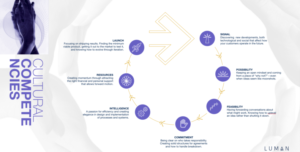Who would want to “go back” to the old office of bland cubicles, rote and CYA work, gossip, drudgery, and all the dysfunctions we already loathed and ridiculed before the pandemic forced us to reshuffle how we work?
But there were things in the past that we all feel the loss of: a sense of camaraderie, those accidental moments of brilliance around the water cooler, clearing something in a quick walk-by conversation instead of having to schedule a meeting and filling up more space in already full calendars — ultimately really experiencing each other as humans not just disembodied heads on a screen. When our microbiomes mingle, the mirror neurons in our limbic systems resonate, when we sense and feel each other, we also co-create differently.
We can’t contain the future in a container of the past. Somehow, though, there is a felt sense that we lost something when we left the office and “went remote”. Sinking productivity levels are a good sign of that, costing businesses millions every day, while frustrating top performers and creating quiet quitting.
It seems some activities like ideating and innovating together, coordinating work, learning and growing together all require us to co-locate, to be physically present with each other — or at least it works much better that way.
So now what? The landscape has shifted, there’s no going back. As a leader, how do you handle this situation and motivate people to return to the office — at least for some of the time?
Making it about time sends the wrong signal. Mandating e.g. 2 days in the office per week makes “work” about butts in the chair for 8 hours rather than actual outcome and ultimately enforces CYA behaviors.
As leaders we can’t crack a whip and force our teams back to the “way it was,” because we learned that there are things that are best done remotely and that there is advantage in giving people the flexibility to determine their own day.
So how do we motivate groups of people back to the office for the collaborative, creative, and innovative work that tremendously benefits from co-location? How do we as leaders motivate people to come to the office to work?
And beyond that even, how can we use this moment in time for the required upleveling of our workforce so they don’t become obsolete in an age of AI?
Understanding Motivation
Classical management theory thought of motivation as a mixture of carrot and whip. Not surprising considering the term “manager” first appeared to describe the role of a circus director who manages animals in the “manège”, the center of the circus. Inherent here is also the bias that a manager would be superior to the animal-like creatures they are motivating with said whip and carrot. It is the equivalent of the super-ego and ego directing the id in Freud’s terms; or of our system 2, our rational system, directing our system 1, our somatic system in Daniel Kahneman’s view. And it really only speaks to our lower levels of psychological development. To the indeed animalistic parts.
This will not work to motivate today’s workforce. After all, they aren’t animals.
Motivation depends on one’s adult level of development
How to motivate someone depends on their level of adult development. Psychologist Robert Kegan determined five initial levels of adult development (LUMAN thinks there are at least seven, but that is a story for another day). We found that adults on different levels are also motivated by different dynamics:
- Impulsive (early childhood and minor percentage of humans rare in today’s workforce) — coercion — motivated by pain and fear of punishment — the metaphorical stick or whip, in modern day the threat of getting fired and losing income and safety
- Imperial (adolescence, 6% of adult population) — desire — motivated by fulfillment of desires and wants to the point of using manipulation and power games if necessary — here the carrot works, e.g. sales boni and similar financial incentives
- Socialized (58% of the adult population) — reason — motivated by following the rules and doing “the right thing”, here an appeal to reason and showing the logic behind why it makes sense can lead to success
- Self-Authoring (35% of the adult population) — choice and values — self-authoring is in many ways synonymous with authentic and autonomous. Adults here are motivated by their own values and principles and by the fact that they are the ones choosing
- Self-Transforming (only about 1%) — exploration — self-transforming individuals are motivated by their aspirational identity, who they could become. Key here is to attach desired behaviors to their next best version of themselves.
At all times, we have all of these levels present on earth at the same time. Even as an individual, one might transition between different levels depending on the situation and the person we are relating to (e.g. we might be coming from a socialized or even self-authoring level at work, while we fall back to imperial behaviors with our partners or children or vice versa). Over the centuries of human evolution, we have shifted the distribution of where most adults are among these levels.
During the age of enlightenment and consequent public education, we shifted a majority of adults — at least in the WEIRD world — from imperial to socialized developmental levels. In school we were in-formed and in-structed in the rules of society, and learned reading and writing sufficiently to follow those instructions. We were rewarded for knowing what was “right” (meaning socially agreed on) and punished for what was “wrong” (or deviated from social norm).
In the last century we began to shift the curve even further. Accelerated by the expansion and export of the American dream, of the individual who “makes it”, we slipped into a society of the mass individualism (as José Ortega y Gasset already pointed out in the late 20s of last century in Revolt of the Masses). The individual, as a consumer, voter, and even self-expressed artist became a new cultural phenomenon. Not surprisingly, reality started to brittle already in the late 90s Wall Street fueled head count reductions, as individuals realized that the socialized work place was not going to serve them any longer.
The current moment — a new human
Now accelerated by the pandemic, many employees have begun to have their first experiences of the self-authoring level of development. Several factors contributed to this new awakening and understanding this is key to motivating your employees to return back to work:
- Isolation and alone time — often for the first time, people spent time alone during the pandemic. Locked into their own four walls, especially the younger generation, who did not have their own families or solid bonds yet, found themselves all by themselves for considerable amounts of time. Being by ourselves — while sometimes painful — also makes us more conscious of our relationships and how we express ourselves and our values in these relationships. It awakens the individual who makes choices and can respond not just react to others in their field.
- Confrontation with the possibility of death — during the pandemic, suddenly even randomly touching a public surface could potentially mean infection and even death. Especially in Western society, we are good at hiding old age and death, so we can be locked into perpetual youth (thank you Madison Avenue). Realizing that one might die due to some random contact made people look at life differently and awakened a focus on one’s own lifetime and the value of each moment.
- Newly gained autonomy — suddenly being able to make choices about when to be in front of one’s computer at home and when to take care of something personal, the household, the partner, the kids, gave people a new sense of self-determination. Feeling one’s own capacity to choose one’s moments empowered a self-authoring perspective.
Understanding this shift is key to understanding how to motivate employees to return to co-located work.
No longer will stick or carrot, coercion or desire, nor even appeal to reason be sufficient to motivate most employees. Co-locating has to now be their choice, based on their values and personal aspirations. It has to be purposeful.
Motivating Self-Authoring Employees Means Giving Choice And Seeking Agreement
Key to self-authorship is choice and agreement. Instead of having expectations from each other based on some more of less implicit socialized cultural rules of the past, we now need to make conscious agreements with each other as to how we are creating the future together.
As a leader, how do you connect to these new needs of your employees?
There are three aspects that correspond to the three awakening elements above:
Belonging creates loyalty and engagement
A side effect of waking up to self is that we perceive self as separate from the world around us. During the pandemic, we really felt the frustration of our social needs, our need for belonging. Creating experiences that offer and foster a sense of belonging are great motivators for co-locating with colleagues. Using the time together not for task work, but for sharing, for experiencing each others’ humanity, for learning and being vulnerable with each other, even for having a good laugh together, creates social bonding and a sense of connection. It fosters loyalty and a sense of camaraderie.
Create time in the office (or even off campus) that is not task or work related, but simply gives your employees an opportunity to be human with each other. Bring together your team to mingle, to share what is happening for them, to celebrate, to connect as humans who are on a team together, and who are “siblings in arms” on a mission to fufill a common purpose.
Purpose provides a common direction and sets up autonomy
One of the key fears we have is that we will one day have wasted our lives in meaningless activity. When aware of our own impermanence, a new dynamic kicks in: wanting to make your life serve a purpose, something transcending your isolated self, something that at once provides a reason to grow beyond oneself, and at the same time provides a sense of belonging to something bigger than oneself. Providing purpose behind your work is another means of motivating people to come together. Especially planning and coordinating activities, and co-creating purpose with your team are activities best done together in person. Having your employees present and together in the room as you develop your strategy together will provide them with a sense of ownership over said purpose, a sense of “all being in this together”, and will allow them to then make decisions independently when working remote.
Bring your team together to plan, to coordinate, to co-develop purpose and visions for what you are going to create each week. Making personal commitments toward each other around purpose will set them up to be autonomous.
Autonomy creates intrinsic motivation
Autonomy is the first of three factors of self-determination theory according to Deci and Ryan, one of the most current thoughts when it comes to the concept of intrinsic motivation (the two other factors being competence and relatedness, the latter already being covered by belonging above).
Autonomy means I have a choice and I can say no. I am not told what to do, I am requested to make an agreement and I can negotiate this agreement or even say no. This is probably the most fundamental shift that leaders need to consider as we are moving from command and control structures toward networked organizations.
As a leader that means you have to become more enrolling and engaging and make requests that your team wants to say yes to. Even the invitation to come back to the office. Extrinsic motivation (sticks and carrots and even social compliance or guilt) no longer works for employees who have had a taste of autonomy.
Invite people back into the office, and give them good reasons to say yes by offering activities that are engaging and speak to their values, whether they create belonging or a sense of purpose, or whether they are opportunites for them to learn and grow, supporting them in their own evolution as individuals.
Looking to the future
Beyond understanding the tools of motivation, the current moment and conversation about co-locating in the office is also a tremendous opportunity to not just upskill, but uplevel your employees to the self-authoring development stage that is required of most of humanity in an age of AI. Self-authoring adults are the foundation for flat hierarchies and distributed decision making, both elements of the organization of the future.
Use this current moment to strengthen your team in their personal development to becoming self-authoring and ultimately even self-transforming adults.
Don’t ask how you can get people back into the office, ask how you can support them in being their best in co-creating together.
Leaders go first
As a leader, this requires you to take the first step (the origin of the word leader). You get to self-transform in your own leadership and leadership style to serve the moment. This requires vulnerability, trusting and even allowing your employees to sometimes disappoint you as they find their way into this new way of working.
LUMAN enables leaders to make these changes by teaching key concepts for this new way of working in our CREATIONCulture course. We have found that even if only one member of the team learns about these concepts, the whole team dynamic tends to shift.
Connect with us to find out more and stay informed about our upcoming work on how to design this current moment of creating the future.





